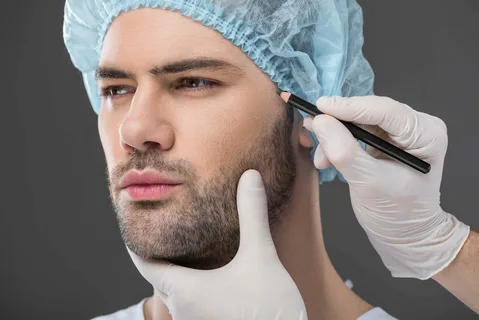Working Time
-
Mon - Sat :
10:00am - 01:00pm
05:00pm - 08:00pm
Contact Info
-
Phone: 7624008000
- recombhtc@gmail.com
Beard Transplant

Cutting-Edge Solution for Genetic Challenges: Beard Hair Transplants
Beard hair transplants provide an advanced solution for individuals facing genetic challenges or other factors that inhibit facial hair growth. Facial hair is closely linked to appearance and masculinity, and its absence or sparse growth can affect confidence, particularly in teenagers.
Before undergoing a beard transplant, it’s essential to understand the anatomy of the procedure. Beard development begins during puberty and continues until the mid-thirties. For the transplant, the face is divided into two sections: frontal and lateral. The lateral section includes the sideburns, jawline, and cheeks, while the frontal section encompasses the goatee and mustache, involving the chin and lower jawline.
Surgeons performing the transplant consider that hair density varies between the mustache and beard. The number of grafts needed varies per individual, typically ranging from 2,000 to 2,500.
Reasons for Getting a Facial Hair Transplant:
- Aesthetic Enhancement: Primarily for aesthetic improvement, it can also address the lack of facial hair growth due to surgical scars or injury.
- Low Maintenance: Post-surgery, minimal maintenance is required. Patients are advised not to shave the transplanted hair for 10-12 days, after which it can be treated like normal facial hair growth.
- Low Risk: The procedure carries minimal risks and side effects, provided it is performed by an experienced hair restoration surgeon.
How is the Beard Hair Transplant Procedure Performed?
- Initial Assessment: The donor areas on the head and face are examined.
- Design Discussion: The beard design and desired density are discussed in detail with the patient, finalizing a plan based on their preferences.
- Health Checks: Blood tests and physical examinations may be required to ensure the patient’s health.
Post-operative care is vital for optimal results. RECOMB provides thorough guidance on caring for the transplanted area to ensure successful outcomes and satisfaction with the enhanced beard.
Procedure Steps:
- Extraction: Follicular units are extracted from the donor area and placed in a holding solution.
- Implantation: The grafts are implanted in the recipient area using implanters or forceps.
Salient Features of Facial Hair Transplant:
- Similarity to Scalp Hair Transplant: The procedure is similar to a scalp hair transplant, involving the extraction of donor hairs from the back or sides of the scalp. These hairs, which match the texture of facial hair, are carefully transplanted to the recipient site. In cases where there is no donor hair on the scalp, body hair, especially from the chest, can be used through the FUE technique.
- Natural Growth: The new facial hair will grow just like normal facial hair, matching its texture and features.
- Virtually Painless: The procedure is practically painless, similar to a regular scalp hair transplant.
When considering hair transplantation, whether for the face or scalp, it is crucial to choose the right surgeon to achieve the best aesthetic outcomes. Our surgeons at RECOMB have vast experience of 7 years in the field of facial and scalp hair transplant.


